|
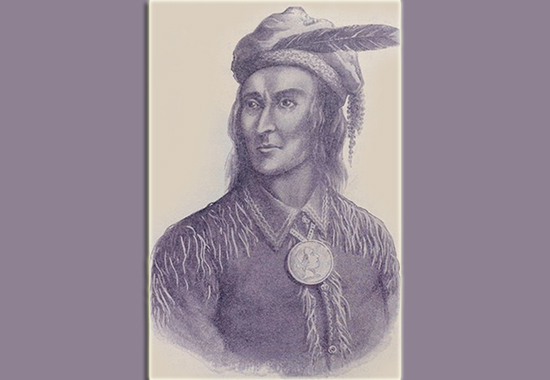
Tecumseh 1768-1813
also
spelled Tecumtha, Tecumthe,
Tikamthe, Tecumtha, or
Tecumsa.
Tecumseh might be
translated as Shooting Star.
|
|
Image Above
Tecumseh in
traditional dress
Sketch by the
French portrait painter and fur trader Pierre Le
Dru (sometimes LeDru), 1808
Later drawings of
Tecumseh, that are based on this sketch, add a
British uniform with epaulettes [the little
table brooms on the shoulders] and a nose ring.
Aboriginal People
in the Canadian Military / National Defence and
the Canadian Forces |
Tecumseh was a chief of the
Shawnee tribe, and, among other
things, a respected human being, the founder of an intertribal Indian confederation, an
admired leader, and a powerful orator.
Here is the map:

Tribes of the Indian
Nation
Click to enlarge
Tecumseh's Family
Tecumseh's mother was a Creek Indian,
see today's Georgia and Alabama on the map above.
Tecumseh's brother was
Tenskwatawa, also called
the Prophet.
His elder sister was
Tecumapease, or Tecumpease. Another elder
brother was Cheeseekau. And yet
another brother was Sauwaseekau.
Tecumseh probably married twice. The
name of his first wife is not known. His second wife was Mamate.
Mamate and Tecumseh had a son, Pachetha.
Mamate died before Tecumseh founded
his confederacy. Pachetha was brought up by Tecumapease, Tecumseh's
sister.
Tecumseh's Character
Although a warrior, Tecumseh did not
tolerate cruelty.
Tecumseh's Brief
Biography
1768 - Birth at Old Piqua near today's
Springfield, Clark county, Ohio. As far as colonists are concerned,
the region is in British hands.
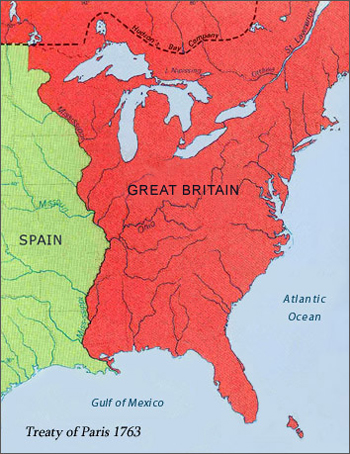
Map of North America After the 1763 Treaty of Paris
 Treaty of Paris 1763
Treaty of Paris 1763
Library of Congress
1774 - Tecumseh's father is killed by
whites, his mother leaves him with the tribe and disappears. The
Shawnee chief Blackfish adopts him.
1775-1783 - American Revolution. Young
Tecumseh fights with fellow Shawnee warriors alongside the British
against the Americans.
1783 - Treaty of Paris
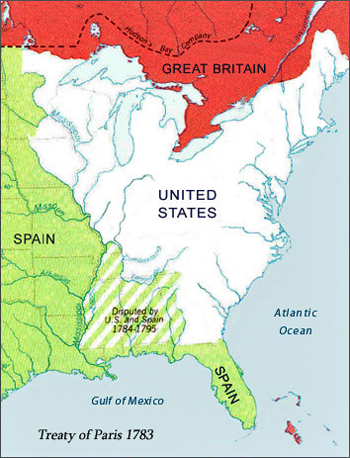
Map of North America
After the 1783 Treaty of Paris
 Treaty of Paris 1783
Treaty of Paris 1783
Library of Congress
After the war, Tecumseh fights along
with
the Cherokees.
1788 - Kentucky frontiersmen begin
raiding native villages
1789 - Fighting between the Northwest
Indian Confederation and the whites breaks out. / George Washington
becomes the first U.S. president.
1790 - General Josiah Harmar and his
punitive expedition, is ambushed by warriors of the Northwest Indian
Confederation, led by Little Turtle, chief of the Miami tribe.
November 4, 1791 -
Saint Clair's
Defeat. Indians of the Northwest Indian Confederation, again led by
Little Turtle, creep up on General Arthur St. Clair's camp of 3,000
men and kill more than 600 of them. Tecumseh serves as a scout with
the Indians.
September 1792 - In a raid near
Nashville, Tennessee, Tecumseh's brother Cheeseekau is killed.
1792 - President Washington makes
Anthony Wayne commander in chief of the U.S. Army, who sets out to
defy Indian resistance. The Shawnee chief Bluejacket rallies Indian
troops to deal with Wayne. Accordingly, Tecumseh moves back into the
Ohio region to lend a hand.
June 1794 - Tecumseh leads a futile
Indian attack on Fort Recovery.
August 20, 1794 - Tecumseh fights in
the Battle of Fallen Timbers, a devastating defeat of the Northwest
Indian Confederation by the Americans, led by General Anthony Wayne.
Tecumseh's brother Sauwaseekau is killed in battle.
August 3, 1795 - As a result of the
Indian defeat at the Battle of Fallen Timbers, the Indians,
represented by Little Turtle, are forced to sign the
Treaty of
Greenville, in which they cede most of Ohio, and large parts of
Indiana, Illinois, and Michigan. This concludes the
Northwest Indian War.
1797 - John Adams becomes the second
president of the U.S.
1799 - Council near today's Urbana,
Ohio, to settle racial differences. Tecumseh stuns the audience with
his eloquence.
May 1800 - Twenty-eight year old
William Henry Harrison is appointed governor of the newly created
Indiana Territory.
January 10, 1801 - Harrison arrives at
Vincennes.
1801 - Thomas Jefferson becomes the
third president of the United States.
1803 -
 Louisiana Purchase
Louisiana Purchase
1804 - An incident near Chillicothe,
Ohio, [the killing of a settler] prompts a council between whites
and Indians at Chillicothe. Violent emotions are flying high on
both sides, Indians and whites. Tecumseh addresses the crowd.
From the confident manner in which he spoke
of the intention of the Indians to adhere to
the treaty of Greenville, and live in peace
and friendship with their white brethren, he
dispelled, as if by magic, the apprehensions
of the whites - the settlers returned to
their deserted farms, and business generally
was resumed throughout that region.
Colonel John
McDonald
1805 - Tecumseh's brother Tenskwatawa,
aka the Prophet, begins to preach peace among all Indian tribes and
calls for a united front against the whites. Tecumseh travels up and
down the country to obtain support and members for his new Indian
confederation.
Summer of 1808 - Tecumseh visits the
British at Fort Malden, Upper Canada. The British are very much
interested in aiding Tecumseh's activities, because they share an
enemy, the United States.
Followers and advocates of the
intertribal Indian
confederacy gather at Prophet's Town on the Tippecanoe River,
Indiana. This assemblage is a mixture of religious revival (Tenskwatawa
claims he had a revelation), devotion to Native American traditions,
resistance to land grabbing by whites, and pure American patriotism,
in its original sense of the word. Tecumseh continues to travel the
country in search of recruits.
1809 - James Madison becomes the
fourth president of the U.S.
1809 - The
Treaty of Fort Wayne, negotiated by William Henry
Harrison between the U.S. and the "Delawares, Shawanoes,
Putawatimies, Miamies and Kickapoos", takes three million acres from
the Natives.
Tecumseh begs to differ:
No tribe has the right to sell, even to each
other, much less to strangers. Sell a
country? Why not sell the great air, the
great sea, as well as the earth. Did not the
Great Spirit make them all for the use of
his children?
Tecumseh to
General William Henry Harrison on August 20,
1810, at Vincennes
 Go here to read the
entire speech
Go here to read the
entire speech
Summer of 1811 - Tecumseh's second meeting with Harrison at
Vincennes. Arriving with Tecumseh at this meeting are several
hundred of his men. This time around there is much more tension in the air,
and the meeting accomplishes nothing.
Tecumseh goes on to recruit troops for his confederacy in the South, while
Harrison finds his absence a great opportunity to attack the Indian
confederation at its core. This will result in the Battle of
Tippecanoe.
Harrison marches up the Wabash River
and sets up camp in close proximity to Prophet's Town.
Tenskwatawa
decides to attack first. The battle that followed marked the
beginning of what became known as
Tecumseh's Revolt. This
revolt will merge with the
 War of 1812.
War of 1812.
November 7, 1811 -
 Battle of Tippecanoe. U.S. victory.
Tenskwatawa flees to Canada. His
men scatter.
Battle of Tippecanoe. U.S. victory.
Tenskwatawa flees to Canada. His
men scatter.
Upon his return, Tecumseh finds his
village in ruins. He braces for war between the Americans and the
British, and decides to cross the Detroit River with his troops, and
to join
the British at Fort Malden.
Encyclopaedia Britannica tells
us that,
There he
brought together perhaps the most formidable
force ever commanded by a North American
Indian, an accomplishment that was a
decisive factor in the capture of Detroit
and of 2,500 U.S. soldiers (1812).
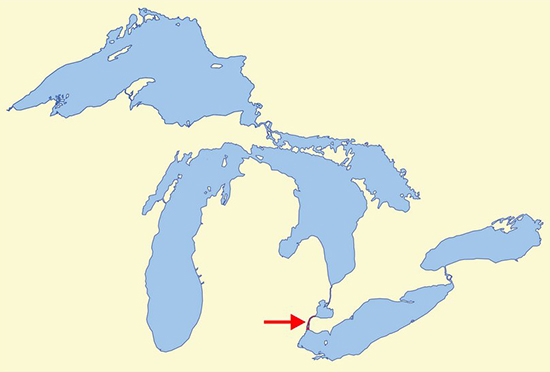
Map Location
Detroit River
Wiki
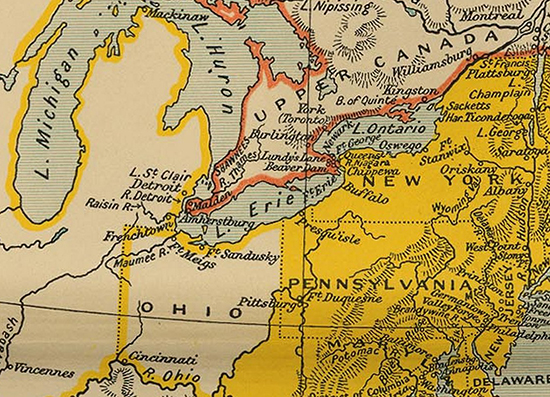
Fort Malden Map
Location
Click to enlarge
June 18, 1812 - The U.S. declares war
against Great Britain. The
 War of 1812 has begun.
War of 1812 has begun.
August 5, 1812 - Tecumseh and his men
ambush a small unit of American troops. This is the
Battle of Brownstown.
 Check this event and more details in the
Timeline of the War of 1812
Check this event and more details in the
Timeline of the War of 1812
August 9, 1812 - Tecumseh, his men,
and British troops attack a U.S. detachment at Maguaga. This is the
Battle of Monguagon
(Maguaga).
 Check this event and more details in the
Timeline of the War of 1812
Check this event and more details in the
Timeline of the War of 1812
August 15, 1812 - The British and
Indians, including Tecumseh, attack Fort Detroit.
August 16, 1812 - Surrender of
Detroit.
Tecumseh continues to travel in order
to find support among the Indian nations. The Alabama Creeks respond
well to his message, but the Chickasaws, Choctaws, and Cherokees do
not.
Tecumseh returns north to join British
General Henry A. Procter in his invasion of Ohio.
May 1, 1813 - First Siege of Fort Meigs,
located on the Maumee River above Toledo. Harrison against Procter.
Procter withdraws on May 9.
May 5, 1813 - Battle of Fort Meigs.
This is part of the Siege of Fort Meigs. In this battle Tecumseh
defeats 800 Americans, led by Colonel William Dudle.
 Check this event and more details in the
Timeline of the War of 1812
Check this event and more details in the
Timeline of the War of 1812
July 21, 1813 - Second Siege of Fort Meigs,
which is Tecumseh's almost brilliant plan to lure the Americans out
of the seemingly impenetrable fort.
 Check this event and more details in the
Timeline of the War of 1812
Check this event and more details in the
Timeline of the War of 1812
On October 5, 1813, Tecumseh is
killed in the Battle of the Thames,
also called the Battle of Moraviantown,
near the Thames River in Upper Canada, today's Ontario.
Check
 this event in the timeline of the War of 1812.
this event in the timeline of the War of 1812.
Tecumseh's Death and
Its Impact on History
Who exactly killed Tecumseh? No one
knows. One of the many unconfirmed rumors is that it was Colonel
Richard M. Johnson, commander of the Kentucky mounted militia.
Where exactly was Tecumseh's body
buried? No one knows. Some say his body was mutilated by U.S.
troops, others say Tecumseh's men buried him.
Either way, Tecumseh's death crushed the Indian confederate resistance as well
as the British-Indian coalition.
Many legends were invented and
Tecumseh became a larger historic figure post-mortem.
More About the
Likeness of Tecumseh
The Smithsonian shows us a more
popular rendering of Tecumseh: Benson John Lossing's engraving of
Tecumseh, based partially on Pierre Le Dru's sketch. Lossing lived
1813-1891.
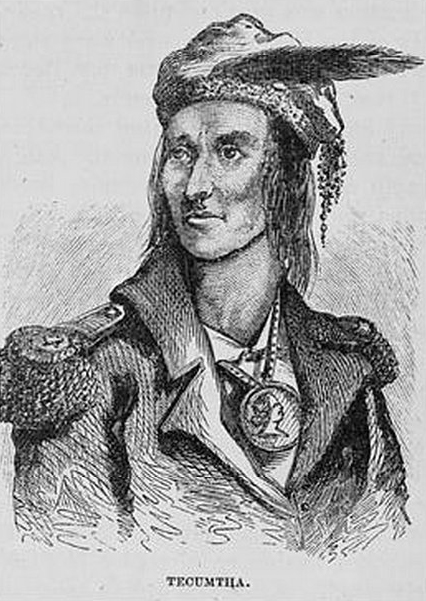
Tecumseh
National Anthropological
Archives, Smithsonian Institution
The Smithsonian:
Composite image of Tecumseh or Tecumtha (The
One Who Passes Across Intervening Space From
One Point To Another) wearing a peace medal,
taken from Benson John Lossing's Pictorial
Fieldbook of the War of 1812. According to a
note by Lossing, he made the "portrait" of
Tecumseh from a Pierre le Dru's pencil
sketch of his head and cap and a rough
drawing showing him in full military dress,
made at Malden shortly after the surrender
of Detroit.

Tecumseh
Le Dru's
sketch copied, enhanced, and engraved by Benson
J. Lossing, and then copied and colored by an
anonymous artist, c. 1812
Toronto
Public Library

Map of the Indian Tribes Around the Great Lakes
Main Indian Groups in Contact with the French in
the Great Lakes region
Library of Congress
Go here for
more
 Maps of the Native
American Tribes
Maps of the Native
American Tribes
More History
|